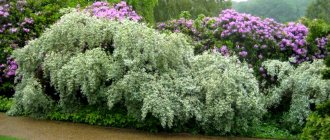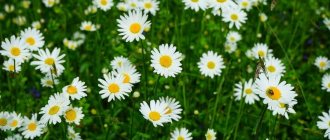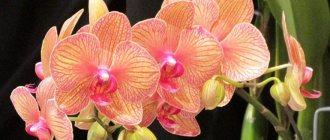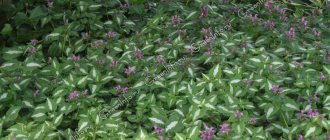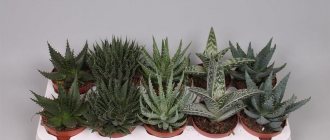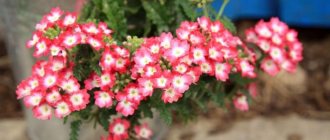Variegated aloe (Gonialoe variegata, formerly known as Aloe variegata) is a perennial herbaceous succulent from the genus Gonialoe, family Asphodelaceae. The genus Aloe was found to be polyphyletic and was divided into the following genera: Aloe, Kumara, Aloiampelos, and Gonialoe. The plant received its name for the variegation of its leaves. Other common names: Aloe tiger, Aloe spotted, Aloe striped.
Botanical description
Attention : In the scientific literature, this variety of aloe is usually called variegata; in order to grow it, you need to know how to properly care for it. Among gardeners, the indoor plant is called Falcon feather or tiger aloe.
This variety belongs to the perennial leaf succulents of the Asphodelaceae family . The homeland is considered to be South Africa and Namibia. In nature it prefers rocky areas. It grows as a compact bush up to 30–35 cm high. The stem is small. The bush is dense, compact.
The peculiarity of the variety is that the leaves grow in three rows and are arranged in a spiral. The leaves are deep green and pointed. They grow up to 12 – 15 cm in length, 4 – 5 cm in width at the base. The lower leaves die over time and turn brown. They gather into a small rosette and tightly entwine the stem. The structure of the leaves is dense and fleshy.
The peculiarity of the variety is the coloring of the leaves . There are white marks - spots - across the entire surface of the leaf. Spots and stripes are located symmetrically on the leaves. The edges of the leaf are covered with small spines. The leaf is triangular in shape, edged with a narrow white stripe. The root is powerful and well branched.
On our website you can find out a lot of useful information about varieties such as Aloe vera, tree, striped and spinous. We also suggest reading the article “Beautiful and unusual aloe mix - medicinal properties of varieties, features of care and propagation,” where you will find a description of many varieties and types of aloe.
Decorative forms
Experts have bred many different varieties of aloe for cultivation for decorative purposes. However, non-selective species can also be grown at home, since even large plants rarely grow to large sizes at home.
If you want to decorate a windowsill or desktop with a miniature plant that does not require frequent watering and special care, you can pay attention to small succulents. These are, for example, the following types of aloe:
- Haworthiform;
- Short-leaved;
- Rauha;
- Squat;
- Squarrosa;
- Bruma;
- Descuana.
Aloe haworthioides looks very interesting and unusual. Without knowing that this plant belongs to the Aloe genus, it is almost impossible to guess.
And this is what aloe Pepe looks like (hybrid Aloe Pepe):
It was obtained by crossing two types of succulents - Descouan and Haworthiaceae.
The Black Jam variety is no less interesting:
With prolonged exposure to the sun, the leaves of this succulent become burgundy in color.
Aloe brevifolia grows the same shape and height, but its leaves are larger, broadly lanceolate, as can be seen in the photo below:
A peculiarity of this species is that the leaves can take on a reddish color under certain conditions. Aloe rauhii also has the same property:
This plant has thin and elongated leaves, united in rosettes with a diameter of about 10 cm. They are covered with small longitudinal spots over the entire surface, and with thorns along the edges.
Artificially bred varieties of this plant are often grown for decorative purposes: Snow Flake, Winter Sky and White Cloud. The first is distinguished by more pronounced white dots, the second by the larger size of the leaves, and the third has an almost white color.
Snow Flake
Winter Sky
White Cloud
Aloe humilis also grows to approximately 20 cm, in rare cases – up to 25-30 cm. An adult plant looks like this:
Its leaves are lanceolate, reaching a length of up to 10 cm and a width of 1.5 cm. Their color can vary from gray-green to gray-blue. The leaves are covered with small thorns on top. The succulent blooms in summer and often even at home.
Aloe squarrosa, whose second name is juvenna, grows up to 30 cm. It is a shrubby plant with a shortened stem. Its leaves are broadly lanceolate, covered with numerous spines.
One of the smallest is Aloe broomii. The height of this plant does not exceed 15 cm. Its leaves are large, lanceolate, with sharp spines along the edges.
The smallest is considered to be Aloe descoingsii. The length of its leaves, collected in compact rosettes, does not exceed 2-4 cm. The succulent grows very slowly, and it takes at least 5 years to form a plant of 4-7 rosettes.
Other decorative forms of these succulents can grow up to 40-60 cm. These plants are grown not only in flowerpots, but also in open ground.
Black-thorned aloe (Aloe melanacantha) grows up to 50 cm. It has large leaves of a deltoid-lanceolate shape, growing up to 20 cm in length and up to 4 cm in width. You can determine the type of plant by the thorns, which are located not only along the edges, but also and on the back of the leaves. The photograph shows that the upper spines are almost black in color, which is why the plant got its name.
A more powerful bush is formed by Aloe perfoliata. Although it also only grows up to half a meter, due to the larger number of leaves the bush appears more voluminous. Like the previous species, it has thorns on the back of the leaves, but they are located only near the tip and are white in color.
Aloe cap-shaped (Aloe mitriformis mill) has a similar appearance. Its leaves are also gray-green, but the spines located on the sides and top are completely white and soft. The height of a succulent can grow from 40 to 100 cm.
Aloe mitriformis f. variegata
This photo shows a young aloe cap:
And this is a hybrid obtained by crossing two species - cap-shaped and variegata (aloe mitriformis x nobilis variegata)
Medicinal and beneficial properties
The diverse and rich chemical composition of variegated aloe:
- Amino acids – glycine, licine.
- Polysaccharides.
- Flavonoids.
- Minerals - iron, chlorine, zinc.
- Vitamins – ascorbic acid, carotene, vitamin B.
In pharmacology, the juice of the plant is used to produce bactericidal preparations for abscesses and other skin inflammations. In medicine it is used as a diuretic. Preparations based on natural raw materials are used for eye inflammation and runny nose. Aloe juice is used internally for digestive disorders .
In folk medicine, a leaf cut in half is applied to wounds and abrasions. The juice has healing properties. For cosmetic purposes against acne, masks and tonics based on plant juice are used.
What to do after buying a plant
Having bought a flower, you need to ensure its careful transportation . Since the plant is not large in size, you can put it in a cardboard box or bag with a hard bottom. On the way, you need to protect the container with the plant from possible mechanical damage. If the purchase occurred in the winter, you should carefully insulate the transported specimen. The container must be wrapped in wrapping paper and plastic bags, alternating layers. Then put the container in a box and wrap it with any insulation on top.
The “new residents” are quarantined at home. For 14 days it should be isolated from other plants. It is not advisable to water the succulent during this period. The exception is if the soil in the pot is too dry. In this case, you can moisten the soil once.
Treatment with fungicides is a mandatory measure. It applies to all newly purchased copies. Even if no lesions were detected during quarantine, the flower is treated with Fitoverm solution (1 ml / 1 l of water) for prevention.
After quarantine, the new pet must be rehomed. You can buy optimized substrate for succulents in the store. It should be remembered that succulents do not tolerate stagnant moisture, so you need to take care of high-quality drainage.
A pot for replanting can be taken from any material, the main thing is that it is not too tight . You need to focus on the roots. There should be 3-4 cm of free space between the walls of the pot and the roots. After transplanting, you need to place the pot in the shade, away from direct rays. Do not water for a week. Then you can transfer the flower to a permanent place.
Home care
Temperature
Variegated aloe does well at room temperature . In summer, the optimal temperature is up to 22 °C. You can take the pots out onto an open loggia or veranda. The flower loves fresh air, but does not tolerate drafts.
In autumn and winter, at rest, the air temperature should be reduced to 10 - 12 °C.
Watering
The flower should be watered moderately, regularly, once a week in the spring and summer . In winter, watering is reduced; light moistening of the substrate is sufficient once every 3–4 weeks.
This variety requires low air humidity up to 40%. The flower does not need spraying. In the summer heat, it is advisable to wipe the leaves with a damp cloth to remove dust once a week.
When watering, water should not fall on the leaves and into the outlet; it should be poured under the root. Watering should be done with warm, settled water.
Light
Aloe Variegata loves well-lit places . You can install pots on south-facing windows. At lunchtime, it is better to shade the windows with a light curtain.
In winter, additional lighting for 3 hours a day is desirable.
Trimming
This flower does not need form-building trimmings from the bush.
After flowering, it is necessary to cut off dried flower stalks . Old, yellowed, lower leaves are also cut off.
Feeding
Fertilizers are applied during the active phase of flower growth, in spring and summer, once a week. In autumn, fertilizing is reduced; it is enough to apply fertilizer once a month.
Special complex mineral fertilizers for succulents are used as fertilizers . Flower growers recommend using ash, humus, and vegetable decoctions as organic fertilizers. Liquid fertilizers are applied through irrigation. Immediately after transplantation, fertilizers are not applied for 2–3 weeks.
Pot
For planting adult flowers, it is recommended to use ceramic or clay pots. As the root grows with age, the plastic pot may tip over. Young seedlings can be planted in plastic flowerpots until they are 2–3 years old.
Planting containers must have drainage holes for good air permeability. The pot should not be very deep, but spacious and wide.
Transfer
For replanting, you should first prepare special soil . The soil should be light, loose, well drained. It is better to purchase a special mixture for succulents in the store. You can prepare the soil mixture at home.
Soil composition for variegated aloe:
Rotted compost – 1 tsp.- Coarse sand – 1 tsp.
- Drainage.
You can also use a mixture of turf soil, leaf soil, sand, in a ratio of 2:1:1.
Flowers are usually replanted in the spring . Young bushes require annual replanting, adult plants are replanted once every 2 to 3 years.
Transplantation scheme:
- A drainage layer 2 cm high is poured onto the bottom.
- The soil is poured.
- The substrate is moistened.
- Transplantation is carried out using the transshipment method; the flower is transferred to a pot along with a lump of earth.
- Air temperature - up to 20 °C.
- Moisten the soil regularly, in small doses.
We recommend watching a video about transplanting variegated (tiger) aloe:
Characteristics
Unlike other varieties, variegated aloe has a very beautiful leaf. Dense green and fleshy, it is decorated with pale olive flecks that form stripes. Hence the name – tiger. There are pointed teeth along the edge.
The plant came to us from South Africa. Like other succulents, it does not require nutritious soil and plenty of moisture. It begins to bloom at the 4th year. This is a rare variety that blooms easily at home, and therefore has a pronounced dormant period.
Tubular inflorescences look exotic and attractive. The color of the petals varies from pale pink to orange-red. For owners of green pets, the flowering of this succulent becomes a real gift.
Reproduction
By shoots
Aloe variegated easily reproduces by apical and lateral shoots . This method is very convenient even for a novice gardener. The shoots quickly take root, practically do not get sick, and quickly adapt.
Shoot rooting scheme:
- Shoots 6–7 cm long are cut off and dried in the shade for 1–2 days.
- The bases of the shoots are treated with charcoal immediately after cutting.
- Drainage and substrate are poured into the pot sequentially.
- Seedlings are treated with any rooting agent.
- They are buried 1–2 cm into the soil.
- Each seedling is tied to a temporary support.
- The soil is not moistened for 5–7 days, then watering is moderate.
- After rooting, the seedlings are placed in separate pots.
Tip : Variegated aloe requires top drainage - a layer of crushed stone is laid on the surface of the soil.
Seeds
This method is less common. The process of growing seedlings from seeds is long, labor-intensive, and requires special conditions .
Seed planting scheme:
The seeds are first soaked in a weak solution of manganese.- Substrate is poured into a wide planting container.
- The soil is treated with a fungicide and is well moistened.
- The seeds are lightly pressed into the soil.
- The seedlings are covered with film or kept in a greenhouse under glass.
- Seed germination temperature is at least 22 °C.
- The greenhouse is ventilated daily for 15–20 minutes.
- When the first leaves appear on the sprouts, the seedlings are planted in small containers for growth.
- In spring, seedlings are planted in pots.
Aloe: pests
Aloe is attacked by both specialized, “succulent” pests, apparently imported from natural habitats, and by non-specialized ones. The key to successful control is correct and timely identification of the pest species. Most pests are visible to the naked eye, but some can only be seen with a magnifying glass.
The main diseases can be: root rot and dry rot.
Root rot
Usually damage occurs due to improper, too wet content, especially in cool weather. The plant can be saved only with early diagnosis of the disease.
Aloe root rot
Root rotting causes long-term retardation of aloe growth (especially during the growing season), stem drying, and lack of response to watering.
If the rotting of the roots is only partial, remove all the affected parts of the roots, and the rest are well sprinkled with coal powder or sulfur and the aloe is planted in fresh soil with a large proportion of sand.
After three weeks, water very carefully. If the roots have rotted completely, you can save the upper part of the stem by rooting it like a cutting.
In this case, part of the stem is cut off so that only healthy, strong tissue remains.
Dry rot
The disease occurs when plants are not maintained properly.
Outwardly, it does not appear for a long time, and no rot is observed. The plant seems to dry out, without noticeably changing color and shape, but it turns out to be completely dry inside. Moreover, all this happens so quickly that the period of “partial defeat” usually does not have time to be noticed.
Dry rot on aloe
Since this disease is transient and no methods have yet been invented to combat it, the plant dies. However, the disease can be prevented by periodically prophylactic spraying with a systemic fungicide.
Diseases
- With excessive watering, the root collar begins to rot. Rot quickly destroys the flower; it is necessary to isolate the diseased plant.
- If the composition of the substrate is incorrect, the flower does not grow, the soil should be replaced, or sand can be added.
- Due to lack of light, the stems become elongated and the leaves lose their attractiveness.
- From an excess of fertilizers, the leaves begin to turn yellow; you should strictly adhere to the timing and proportions of fertilizing.
- Treating the bush with an alcohol or soap solution will help against scale insects and spider mites.
Growing problems
Aloe tree, or agave, unfortunately, often suffers in our apartments.
It is rather grown for medicinal purposes, regularly plucked and given little care. But if you grow this plant correctly and do not cut off its leaves, you can get very beautiful specimens. Most often, aloe plants suffer from excess moisture; if watering is too frequent, the roots rot and the plant dies. Aloe plants also often suffer from lack of sunlight, especially in winter. At the same time, their stems are elongated, the leaves are smaller and sit less frequently on the trunk. On the contrary, on western or southwestern window sills, aloe may lose its decorative effect - the leaves turn red and thin, but as soon as it is moved to a more gentle sun (eastern or northwestern side), the bush turns green again.
This plant does not benefit from planting in heavy clay soil. Moisture evaporates poorly and there is no aeration, and soil that dries out for a long time inevitably leads to the formation of rot.
If you ask about pests, any granny who grows agave will be surprised - most likely, she has never heard that it has pests. And if something withers, we’ll root a branch and grow a beautiful bush again. In fact, pests such as mealybugs and scale insects can appear on aloe. Both are easy to spot. Scale insects look like white cotton balls in the axils of the leaves, under the husk of old dead leaves on the trunk, and scale insects are noticeable on leaves wrinkled from lack of moisture and nutrition as brownish pimples, sometimes translucent. If you notice something similar on aloe, you need to thoroughly rinse the plant and wipe with a soapy sponge. Then rinse, spray and water with aktar solution. Repeat treatment after a week.
